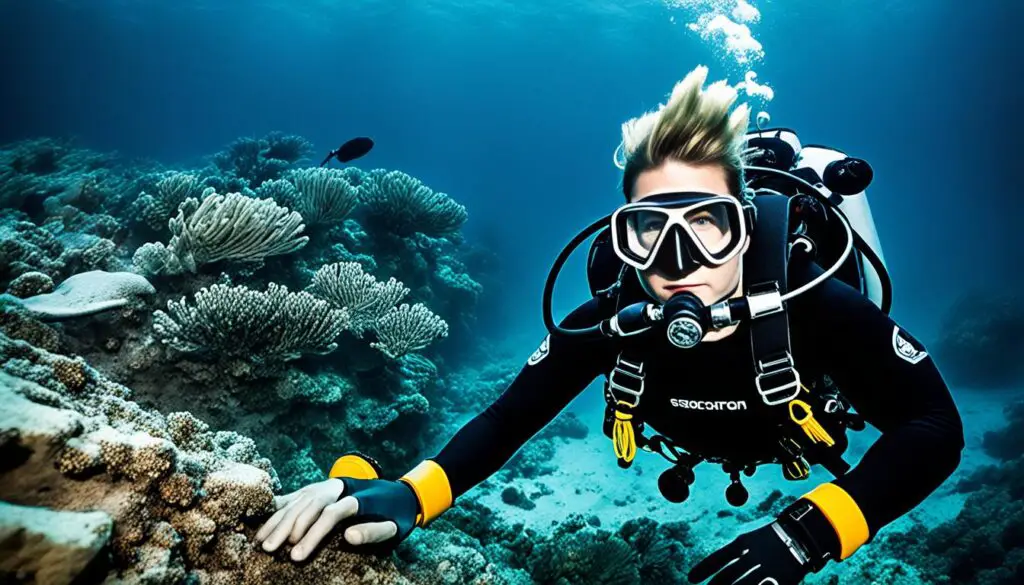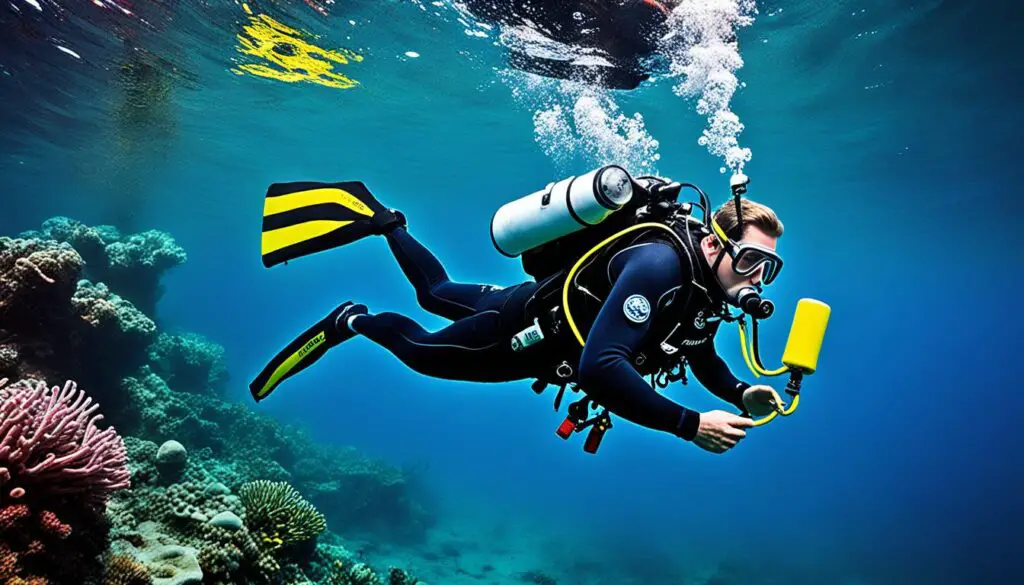Dive depth alarms are essential for safe underwater diving. They help divers know their depth and limits. Dive computers often have depth alarms and an MOD alarm for nitrox mixes.
Some might wonder if depth alarms are needed because divers should track their depth. This alarm also reminds them about MOD safety limits for their nitrox mix. The MOD alarm keeps divers safe by alerting them about approaching dangerous pO2 levels while allowing settings to be personalized.
Key Takeaways:
- Dive depth alarms are critical for ensuring safety during underwater diving.
- Many dive computers have both a depth alarm and a separate alarm for the maximum operating depth (MOD) of the nitrox mix.
- The depth alarm can be set for the maximum dive depth and the MOD of the nitrox mix.
- The MOD alarm alerts divers when they are nearing or exceeding the MOD for their specific nitrox mix.
- Set points for the MOD alarm are adjustable, providing flexibility for divers based on their preferences and dive plans.
Importance of Diving Alarms
Diving alarms are key for keeping divers safe. Normally, dive computers make sounds or flashes when something is going wrong. For instance, they warn if you’re going up too fast, or oxygen levels are too high.
Depth and time alarms on dive computers help divers stick to their plans. They make sure divers don’t go too deep or stay down too long. This is important because it stops too much nitrogen from getting in their bodies.
Dive alarms don’t just warn about dangers. They remind you to check important things, like your computer’s battery. These reminders are a great safety backup and cut down on dangers.
“Diving alarms provide timely warnings, helping divers monitor their dive limits and avoid dangerous situations underwater.”
Safety stops are part of good diving habits and are supported by alarms. They let divers take a break before coming up. By setting up safety stop alarms, divers are reminded. This helps avoid getting the bends.
It’s smart for every diver to use depth and time alarms. They give instant details about your dive and keep you safe. You’ll dive with more confidence and peace by using these alarms.

Benefits of Diving Alarms:
- Enhance dive safety by alerting divers when important limits are approached
- Provide real-time information about depth, dive time, and other critical parameters
- Promote the practice of safety stops for decompression and orientation
- Prevent potential issues by prompting preventive actions, such as replacing low batteries
- Offer divers a greater sense of confidence and peace of mind
| Alarm Type | Function |
|---|---|
| Audible Alarms | Sound alerts when approached or exceeded important dive limits |
| Visual Alarms | Displays warning symbols or messages on the dive computer screen |
| Dive Limits Alarms | Alerts divers when depth or dive time exceeds predefined limits |
| Dive Time Alarm | Warns divers when their dive time exceeds the set limit |
| Depth Alarm Limit | Notifies divers when their dive depth surpasses a specified limit |
The Purpose and Procedure of Safety Stops
Safety stops are crucial for scuba divers, helping them stay safe when they come back up. When diving below 10 meters (32 feet), divers pause at 5-6 meters (15-20 feet) for 3 to 5 minutes. This lets them safely get rid of the extra nitrogen in their body, reducing risks.
The air we breathe underwater contains nitrogen. But if we come up too fast, this nitrogen can form bubbles in our body. These bubbles are bad and can make us very sick. Safety stops give time for the nitrogen bubbles to safely leave our body.
When it comes to safety stops, how you come up is just as important as the stop itself. Coming up too fast can make the stop useless and increase sickness risks. Divers should go up slowly, around 3 meters (10 feet) per minute, as they were taught.
Also, how you position your body matters for a good safety stop. Divers should aim to stay straight or a bit head-up. This helps nitrogen leave our body evenly and without problems. The right position makes sure our whole body gets rid of the nitrogen safely.
Using safety stops and following the right steps makes diving safer and more enjoyable. Divers need to keep track of their depth, time, and the need for safety stops. This way, they keep themselves healthy and avoid dangerous sickness.

| Benefits of Safety Stops | Procedure for Safety Stops |
|---|---|
|
|
Conclusion
Safety is key in underwater diving. Dive depth alarms and safety stops are key. Dive depth alarms alert divers to when they reach their dive limits. This helps keep them within safe levels.
Safety stops help decompress and remove excess nitrogen before going up. By following the right steps and using dive computers properly, divers lower injury risks. Divers should keep good buoyancy and positioning during safety stops.
Remember, every dive should include a safety stop, regardless of depth. Safety should always be top priority, with divers strictly following safety rules. This is vital for every diver’s health and safety.
FAQ
What are dive depth alarms?
Dive depth alarms are key for staying safe underwater. They’re found in dive computers. These alarms warn divers when they’re too deep.
How do dive depth alarms work?
They’re usually set to the maximum dive depth. This alerts divers when they’re close to their limit. Dive computers can also warn about reaching dangerous nitrox mix depths.
Why are dive depth alarms important?
They keep divers from going too deep. Dive depth alarms remind divers to watch their depth. This adds more safety to their dives.
Should I rely solely on dive depth alarms?
Being aware of your depth is vital. While helpful, dive alarms are not the only safety. Use them along with your own monitoring and caution.
Can I adjust the settings of dive depth alarms?
Yes, you can change dive depth alarm settings on most computers. This includes the maximum depth and nitrox MOD. It lets you tailor the alarms to your needs.
Are safety stops necessary?
Safety stops are crucial for scuba divers. They help the body release excess nitrogen safely as you rise from the dive.
When should safety stops be performed?
If diving deeper than 10 meters, stop at 5-6 meters. This should last 3 to 5 minutes. It helps your body decompress safely.
Why are safety stops necessary?
They allow time for nitrogen to leave the body. This lowers the risk of decompression sickness. Skipping a safety stop can lead to dangerous bubbles in the blood.
Are depth and dive time alarms important?
Yes, all divers should use these alarms. They are crucial for sticking to your dive plan safely. These alarms warn if you’re going too deep or staying down too long.
